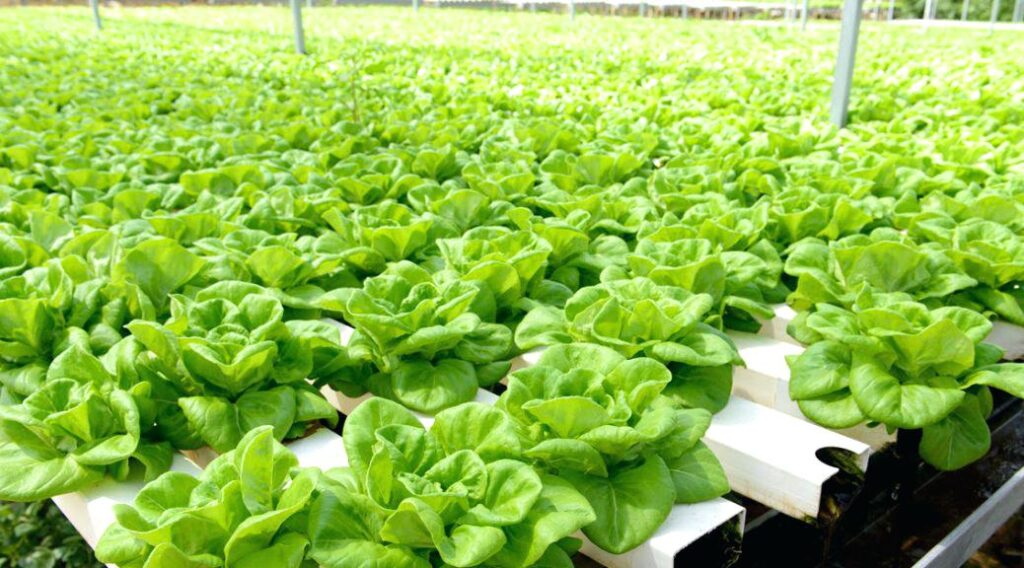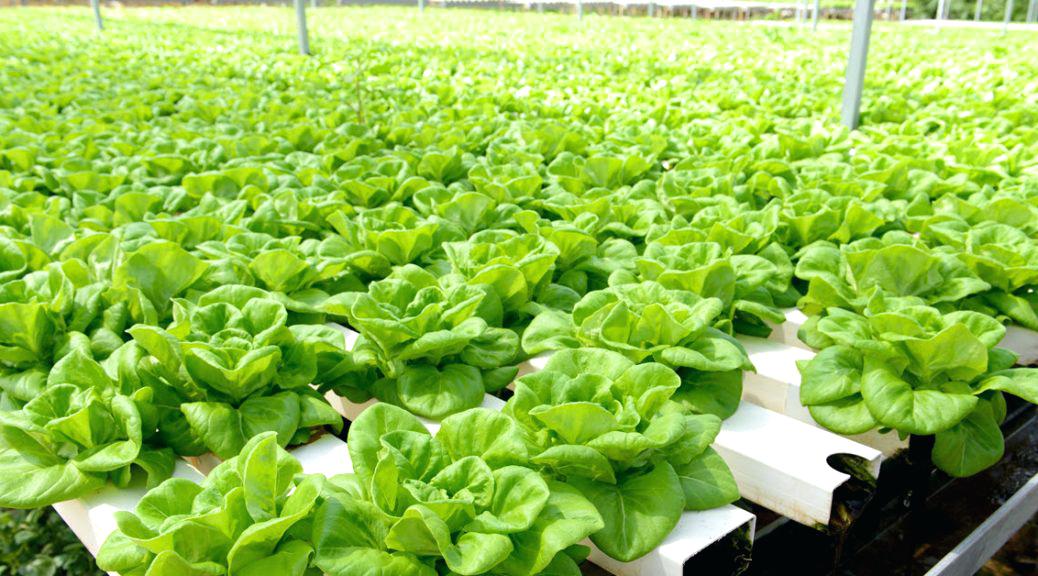Hydroponic gardening, or gardening without soil, is a popular technique employed by many indoor horticulturists because of its accelerated growth rates and prolific yields. Traditional hydroponic fertilizers consist of compounds such as calcium nitrate, potassium nitrate, mono potassium phosphate, and various water soluble micronutrients. These particular fertilizers are readily available for absorption, which means as soon as they make contact with the plant’s roots, they can be absorbed by the plant. In fact, the readily available nutrients are what typically make plants in a hydroponic system display accelerated and balanced growth. A hydroponic nutrition solution contains a balanced meal of ready-to-be absorbed nutrients so plants grown in traditional hydroponic systems never have to wait for nutrients to become available.

Organic gardening, on the other hand, relies mostly on a soil or medium, which houses an entire world of beneficial microorganisms. Most organic gardening methods focus on supporting a healthy population of beneficial microbes within the soil or medium. Organic ingredients added to the soil will be broken down by the microbes and converted into readily available nutrients for the plants. Although there are some difficulties associated with using an organic nutrient regimen compared with a carefully calculated synthetic nutrient regimen, many organic growers are still incorporating organics into their hydroponic growing systems.
Hydroponic Systems for Organic Gardening
The first thing any potential organic hydroponic gardener should take into consideration is the type of hydroponic system to use. Some hydroponic systems are simply more compatible with organic nutrients than others. A general rule of thumb is to use a hydroponic method or system that incorporates a decent amount of medium in the planting container. Systems that are devoid of a grow medium or those systems where the majority of the plant’s roots are suspended in the nutrient solution are less compatible with organic hydroponic gardening. Systems without a planting medium will not be able to house the beneficial microorganisms that organic growers rely on to break down the organic matter into usable nutrients. A hydroponic system, such as deep water culture, where the majority of the plant’s roots are suspended in the nutrition solution, can pose some major issues for organic hydroponic growers. Without a medium, it isn’t possible to establish a large beneficial microbial population. Deep water culture and aeroponic systems are the most compatible with synthetic, water-soluble fertilizers which can be delivered directly to the plant’s roots.
Aquaponics are hydroponic systems that are ideal for organic gardening. As long as there is a good balance between fish and plants and the right bacteria is present for mineralization, aquaponics is one of the most straightforward types of organic hydroponic systems available. Other hydroponic systems commonly used with organic nutrients include ebb-n-flow systems, wick systems, and top-feed systems. Generally speaking, these systems use a planting container that holds enough growing medium to harbor a large population of microorganisms. The all-important microorganisms contained in the medium will aid in breaking down organic matter and converting it into readily available nutrients.
Organic Media for Hydroponics
There are no set rules as to which medium should be used for organic hydroponic gardening. It is important that the medium is well aerated so it is fast draining. Mixing a small amount of compost into an inert hydroponic medium will add some already mineralized nutrients and allow the medium to quickly establish a beneficial microorganism population. It is highly recommended to use a specific beneficial microorganism supplement to inoculate the medium prior to planting. This way, the medium will already have an established population of the microbes needed to convert organic matter into usable nutrients. Coco fiber is a very common hydroponic medium. By adding some worm castings and perlite, an organic hydroponic grower can create a medium that is well aerated and contains some vital nutrients. A prepackaged soilless medium is also a good substrate for organic hydroponics. Although they can be used for organic hydroponics, hydroponic media, such as stonewall and hydroton, may be more finicky than a medium that more closely resembles a soil.
Regardless of which medium he or she chooses for his or her organic hydroponic system, a grower should inoculate the medium with beneficial microorganisms before firing up the hydroponic system. Microorganisms are literally the digestive tract of an organic hydroponic system. Without them, the plants will not receive the proper nutrition needed for accelerated growth. Another option commonly used by organic hydroponic growers is to incorporate an organic soil into a hydroponic system. This creates a sort of hybrid-hydroponic system. With this type of set up, an organic grower can inoculate the soil with microbes and rely on the soil to act as an effective buffer against pH fluctuations.
Organic Nutrients
The good news for organic hydroponic growers is nutrient manufacturers continue to advance their methods and products to best meet the needs of the consumers. Advancements in hydroponic fertilizers continue to be developed and organic liquid fertilizers are no exception. In the last 15 years, there has been much advancement in the processing, extraction, and stabilization of organic compounds. In fact, there are many pure organic or organic-based liquid fertilizers on the market that can be incorporated into a hydroponic system. When shopping for prepackaged organic liquid fertilizers, be sure to check if the product is designed to be used in soilless media. Generally speaking, the organic “soilless” fertilizers will be filtered and specifically processed for use in a hydroponic system. Purchasing soilless-specific organic fertilizers can go a long way in preserving the longevity of pumps and emitters which could otherwise get clogged by organic sludge in a recirculating hydroponic system.
Vermiculture
Compost and worm teas are extremely good liquid fertilizers for organic hydroponic systems as they contain readily available nutrients and beneficial microorganisms. Unfortunately, these teas do not have a long shelf life, which means the grower needs to source it locally or make it him- or herself. Vermiculture, or worm-farming, is an extremely efficient way to transform raw, organic materials, such as limestone, fish meal, bone meal, and guano, into usable nutrients for hydroponic systems. A highly motivated, organic purist could theoretically set up a worm farm to process organic matter into worm castings, and then, by brewing a tea, further process the worm castings into an organic hydroponic nutrient formula. Growers who do not have the time, space, or inclination for such a venture can opt to purchase worm casting or organic compost to brew into a tea or blend into the hydroponic medium.
PPM and pH
In a typical hydroponic system, the concentration of the nutrients is measured in PPM (parts per million) or EC (electric conductivity). PPM or EC meters rely on the electric conductivity of the nutrient solution to produce an accurate reading. Many organic compounds do not register on a PPM/EC meter, so it may be difficult for a grower to measure the exact nutrient concentration in an organic hydroponic system. Despite this, most organic hydroponic growers still measure PPM/EC and then use the reading as more of a reference point than a definitive measurement. The potential hydrogen, or pH, is another important factor in a hydroponic system. It is generally best to let the pH of an organic hydroponic system stabilize on its own. In most cases, the pH of a properly working organic hydroponic system will be higher (more basic) than in a typical hydroponic system. This makes sense when it is considered that the optimal pH for nutrient absorption within a soil is slightly higher than the optimal pH for nutrient absorption in a traditional hydroponic system.
Like any hydroponic garden, an organic hydroponic system will require some experimentation. No two gardens are exactly alike and each will need to be uniquely tweaked to maximize productivity. In the case of aquaponics, a grower should establish a balance between the fish waste and bacteria needed to convert the waste into plant food before the plants enter the system. In a similar way, organic hydroponic growers can inoculate their media and allow the nutrient solution’s pH to stabilize before adding plants to the system. As with traditional hydroponic systems, an organic hydroponic system will benefit from the daily monitoring of the nutrient solution’s aeration, temperature, nutrient concentration, and pH.
Organic hydroponic growers should not be afraid to mix and match various prepackaged organic liquid fertilizers until they find the blend that is the best fit for their particular crop. When experimenting with an organic hydroponic system, it is important to make sure it is an enjoyable adventure. If a grower enjoys experimenting, the (sometimes long) process of finding the perfect blend of organic ingredients and nutrients will not seem like a chore. After all, hydroponic gardening is supposed to be a fun and rewarding experience for both organic and conventional growers. Once a gardener has established the type of system, decided on a medium for housing the beneficial microorganisms, and dialed in his or her organic nutrition regimen, he or she can sit back and enjoy watching the organic hydroponic fruits of his or her labor grow.
Eric Hopper resides in Michigan’s beautiful Upper Peninsula where he enjoys gardening and pursuing sustainability.
Related Articles & Free Email Newsletter
Deep Cleaning in the Greenhouse
Plant Propagation Calendar – What You Should Be Doing Each Month of the Year





Comment here